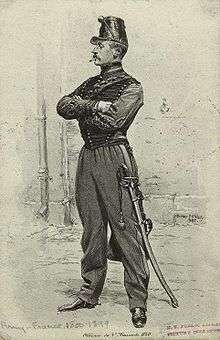4th Hussar Regiment (France)


- Not to be confused with the Hussards de Saxe, who held the title 4th Hussar Regiment from 1791 until its defection in 1793.
The 4th Hussar Regiment (4e régiment de hussards) is a hussar regiment in the French Army, raised and embodied in 1783 and still in existence.
History
It was created as the hussards Colonel Général on 31 July 1783 for the Duke of Chartres, by taking one squadron from each of the Bercheny, Chamborant, Conflans and Esterhazy regiments of hussars. On 30 May 1788 it was reinforced by a contingent of soldiers taken from the régiment de Quercy, régiment de Septimanie, régiment de Nassau, régiment de La Marck, régiment de Franche-Comté and régiment des Évéchés, all then cavalry units.
The hussars played a prominent role as cavalry in the Napoleonic Wars (1796–1815). As light cavalrymen mounted on fast horses, they would be used to fight skirmish battles and for scouting. Most of the great European powers raised hussar regiments. The armies of France, Austria, Prussia, and Russia had included hussar regiments since the mid-18th century. In the case of Britain four light dragoon regiments were converted to hussars in 1806–1807.
Hussars were notoriously impetuous, and Napoleon was quoted as stating that he would be surprised for a hussar to live beyond the age of 30 due to their tendency to become reckless in battle, exposing their weaknesses in frontal assaults. The hussars of Napoleon created the tradition of sabrage, the opening of a champagne bottle with a sabre. Moustaches were universally worn by Napoleonic period hussars, the British hussars were the only moustachioed troops in the British Army—leading to their being taunted as being "foreigners" at times. French hussars also wore cadenettes, braids of hair hanging either side of the face, until the practice was officially proscribed when shorter hair became universal.
The uniform of the Napoleonic hussars included the pelisse: a short fur edged jacket which was often worn slung over one shoulder in the style of a cape, and was fastened with a cord. This garment was extensively adorned with braiding (often gold or silver for officers) and several rows of multiple buttons. Under it was worn the dolman or tunic which was also decorated in braid.
On active service the hussar normally wore reinforced breeches which had leather on the inside of the leg to prevent them from wearing due to the extensive time spent in the saddle. On the outside of such breeches, running up the outside was a row of buttons, and sometimes a stripe in a different colour. A shako or fur kolpac (busby) was worn as headwear. The colours of dolman, pelisse and breeches varied greatly by regiment, even within the same army.
The French hussar of the Napoleonic period was armed with a brass hilted sabre, a carbine and sometimes with a brace of pistols, although these were often unavailable. The British hussar was armed, in addition to his firearms, with the 1796 pattern light cavalry sabre.
A famous military commander in Bonaparte's army who began his military career as a hussar was Marshal Ney, who after being employed as a clerk in an iron works joined the 5th Hussars in 1787. He rose through the ranks of the hussars in the wars of Belgium and the Rhineland (1794–1798) fighting against the forces of Austria and Prussia before receiving his marshal's baton in 1804 after the Emperor Napoleon's coronation.
On the French Revolution, it was numbered as the 5th Hussar Regiment during the army reorganisation of 1 January 1791, as the fifth oldest cavalry unit in the French army, before being promoted to 4th Hussar Regiment in 1793 after the previous holder of that title. In 1814, just before the fall of the First French Empire, it was renamed the régiment des hussards de Monsieur, though it resumed the title of 4th Hussar Regiment during the Hundred Days before being disbanded on the Bourbon Restoration which followed.
In 1816 the régiment des hussards du Nord was formed and in 1825 this unit took the title 4th Hussar Regiment. It survived until 1940, when it was disbanded. On 15 February 1945 a new 4th Hussar Regiment was formed by splitting-off elements of COABC 405. On 30 October 1945 the new unit was disbanded and turned into the 2nd Hussar Regiment. On 15 July 1956 the 4th Hussar Regiment was again recreated, this time from elements of 251e B, before being disbanded again in 1958. It was re-created yet again on 1 April 1959 from elements of 31st Dragoon Regiment, surviving until 1964, when it was disbanded to become the 8th Dragoon Regiment and immediately recreated from elements of 1st African Chasseurs (1er régiment de chasseurs d'Afrique) and from the instruction centre of the 6th Dragoon Regiment. This unit was disbanded at Laon, with its colours being entrusted to the GMR/6-4e RH).
In 1991 the 4th Hussar Regiment was yet again recreated, becoming the support regiment to the RMD-NE/CMD Metz. In 2000 it took the name of 4th Hussar Squadron Group (4e Groupe d'escadrons de hussards or 4e G.E.H), which it still holds.